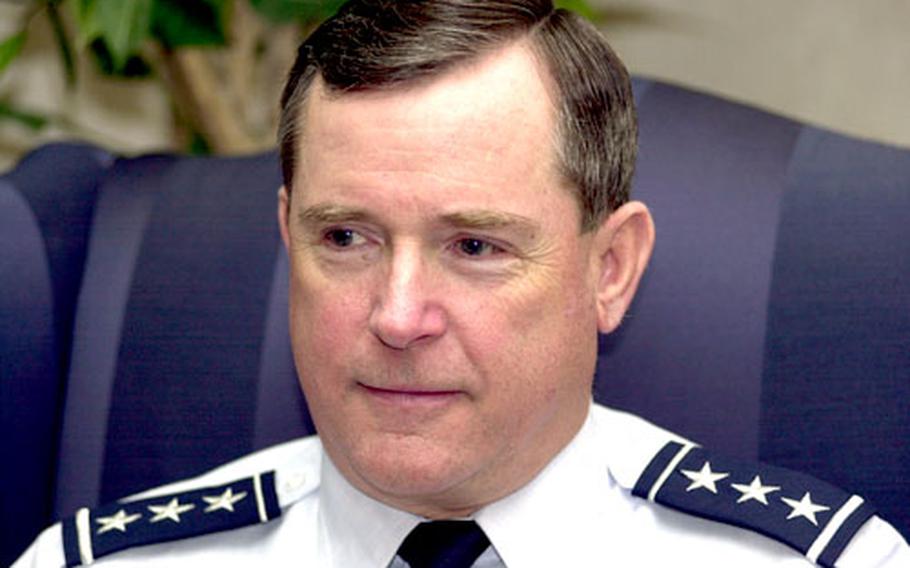
Lt. Gen. Thomas C. Waskow, commanding general of U.S. Forces Japan and 5th Air Force, attended DOD schools in Japan for two years and in London for two more, and is a 1970 graduate of the Air Force Academy. (Dave Ornauer / S&S)
Starting at the middle-school level, DODEA-Pacific officials go to great lengths to make students aware of scholarships, aid opportunities and other resources for funding education, spokeswoman Mary Hibbs said.
“This includes making thoughtful decisions about their high school program, developing career options, pursuing rigorous academic course work, engaging in extracurricular activities and looking at opportunities to finance post-secondary education,” Hibbs said.
Of the $30,270,321 in scholarship money awarded to DODEA-Pacific students the past three years, $21,338,500 — 70 percent — was earmarked for ROTC scholarships and appointments to military academies, according to DODEA-Pacific’s annual reports.
Hibbs indicated those numbers might be higher, since scholarship-aid data is reported to students by counselors “and may not reflect the actual or all awards,” she said. “Monetary awards and family financial status are not required to be disclosed.”
Still, the annual reports show the overwhelming share of that Pacific funding goes to academy appointees and ROTC scholarship recipients. But the process of earning one is hardly clear-cut. Certain areas have a clearly defined pipeline, from JROTC prep program to ROTC scholarship or academy to a commission. Retired Lt. Col. Don Hedgpath, in charge of Seoul American’s JROTC program in Korea the past 10 years, has had “several hundred” go that route.
“No one does it better in the Pacific than Seoul American,” said Hedgpath, who last year saw 35 percent of his cadets go into college ROTC, academies, the reserve corps or active duty. Seoul American’s enrollment is 640, and 265 are in JROTC — 135 of them seniors, with 18 student-athletes in line for four-year scholarships or academy appointments alone.
By contrast, Kubasaki on Okinawa, with 126 of its 683 students in Marine Corps JROTC this year, had just one cadet pick up an ROTC scholarship in nine years.
“Isn’t that weird?” asked retired Marine Maj. John Glenn, who’s guided the program since its inception in 1993-94. “I’ve had one cadet earn an ROTC scholarship. None has gone to a service academy. I know it seems odd, but that’s the facts.” Some recipients don’t even join a DODEA-Pacific JROTC program.
Take Gary Harris, a Kadena High senior on Okinawa. He found that the classes clashed with other courses he wanted to take but wound up with an ROTC scholarship to University of Washington anyway. “For some of us, our schedules wouldn’t fit,” he said.
So instead, he had to maintain a GPA of 3.0 or above, take a physical aptitude test, and interview with a JROTC instructor at Kadena and an Air Force ROTC liaison in the United States.
The son of Lt. Col. William Harris of Kadena’s 18th Mission Support Group had his eye on an ROTC scholarship “since I was a freshman,” he said, adding that he’s going for an engineering degree.
Where the money is ...
Scholarships awarded to DODEA-Pacific students:
2001-02 school year:
ROTC scholarships: 79, $5,530,000
Military academy appointments: 14, $3,500,000
Grants/financial aid: 98, $1,169,908
State or institutional: 81, $924,544
Local: 257, $412,370
Special: 18, $67,555
Vocational: 1, $3,500
National merit: 1, $2,500
Other: 1, $1,500
Total: 550, $11,611,875
2000-01 school year
ROTC scholarships: 72, $4,794,000
Military academy appointments: 8, $2,000,000
State: $1,569,991
Grants/financial aid: $897,313
Local: $383,375
Vocational: $248,950
Special interest: $145,541
National merit: $44,000
Total: $10,083,170
1999-2000 school year
ROTC scholarships: 61, $4,684,500
Military academy appointments: 4, $830,000
State: $1,508,243
Grants/financial aid: $894,533
Local: $454,688
Special areas: $203,312
Vocational: not reported
Total: $8,575,276
Junior ROTC membership by school
Japan
E.J. King Navy JROTC — 113 of 246 students, Grades 8-12, 46 percent. First-year program.
Matthew C. Perry Marine Corps JROTC — 30 of 264 students, Grades 9-12, 11 percent. First-year program.
Robert D. Edgren, Air Force JROTC — 105 of 589 students, Grades 8-12, 18 percent.
Zama American, Army JROTC — 157 of 418 students, Grades 9-12, 38 percent.
Yokota, Army JROTC — 149 of 411 students, Grades 9-12, 36 percent.
Nile C. Kinnick, Navy JROTC — 131 of 613 students, Grades 9-12, 22 percent.
Total — 685 of 2,541 students, 27 percent.
Okinawa
Kadena, Air Force JROTC — 293 of 894 students, Grades 9-12, 33 percent.
Kubasaki, Marine Corps JROTC — 106 of 683 students, Grades 9-12, 16 percent.
Total — 399 of 1,577, 25 percent.
Korea
Seoul American, Army JROTC — 265 of 640 students, Grades 9-12, 41 percent.
Osan American, Air Force JROTC — 65 of 189 students, Grades 9-12, 34 percent.
Taegu American, Army JROTC — 77 of 152 students, Grades 9-12, 51 percent.
Pusan American, Army JROTC — 36 of 52 students, Grades 9-12, 69 percent.
Total — 443 of 1,033, 43 percent.
Guam
Guam High, Air Force JROTC — 89 of 439 students, Grades 9-12, 20 percent.
Regional total — 1,616 of 5,590 students, 29 percent.